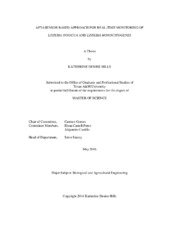| dc.contributor.advisor | Gomes, Carmen | |
| dc.creator | Hills, Katherine Denise | |
| dc.date.accessioned | 2016-07-08T15:06:31Z | |
| dc.date.available | 2018-05-01T05:49:49Z | |
| dc.date.created | 2016-05 | |
| dc.date.issued | 2016-01-15 | |
| dc.date.submitted | May 2016 | |
| dc.identifier.uri | https://hdl.handle.net/1969.1/156824 | |
| dc.description.abstract | Listeria monocytogenes is one of the most common causes of food illness deaths in the world, with multiple outbreaks in the United States alone. The goal of this study was to design biosensors using aptamers with the capability of rapid detection of this potentially deadly pathogen. The biosensor design process involved the use a nano-metallic hydrid platform consisting of a platinum/graphene/platinum (PGP) and PGP+chitosan nanobrush platforms functionalized with aptamers. Polyclonal goat based anti-Listeria antibodies were also attached to both platforms to test their capabilities as a biosensor and to compare aptamer specificity. The PGP+chitosan sensors were controlled by the pH sensitivity of the chitosan (CHT) brushes. The detection of the target bacteria relied on the sensors’ electrochemical response based on impedance changes caused by the L. innocua or L. monocytogenes attachment onto the bio-recognition agents. Each sensor tested had a detection time of approximately 17 min including 15 min for bacteria capture and approximately 2 min to run EIS test. Capture efficiency tests were performed on the PGP+CHT platform based on brushes actuation with pH to determine the optimum testing conditions. The best testing condition was observed when the electrode was first placed in a pH 5 suspension with bacteria and then tested at pH 7 in PBS. For the PGP platform, the highest ESA value (0.0718 ± 0.029 cm^2) found was for the PGP+400 nM thiol aptamer sensor and when impedance testing with bacteria was conducted the highest sensitivity (12.14 ± 1.79 1/log(CFU/mL) and lowest limit of detection (LOD) (11.2 ± 0.79 CFU/mL) value. For the PGP+CHT platform, the best results were found for the PGP+CHT+100 nM aptamer sensor in the presence of L. innocua with a sensitivity of 12.14 ± 1.79 1/log(CFU/mL) and a LOD of 9.1 ± 1.1 CFU/mL. Furthermore, this sensor was able to detect bacteria over a wide range from 10 – 10^7 CFU/mL. The sensitivity of the PGP+CHT+100 nM aptamer sensor was also measured in the presence of L. innocua and S. aureus suspensions containing equally increasing concentrations and had a sensitivity value of 14.25 ± 1.69 1/log(CFU/mL) and a LOD of 9.4 ± 0.11 CFU/mL. This means that this sensor will be very selective towards Listeria spp. and should only detect these bacteria when in a medium that contains other pathogens. Furthermore, PGP+CHT+bio-recognition agent biosensors were also tested in vegetable broth. The LOD for the PGP+CHT+100 nM aptamer was 31.12 ± 0.64 CFU/mL and the PGP+CHT+200 nM antibody was 23.9 ± 0.96 CFU/mL. The aptamers had a sensitivity of 3.76 ± 0.34 1/log(CFU/mL) and the antibodies had a value of 4.9 ± 0.4 1/log(CFU/mL) which were not statistically significant, implying that other bio-recognition agents could be attached to the PGP+CHT platform and have similar detection capabilities. Both PGP and PGP+CHT sensor platforms were comparable to each other in terms of LOD, sensitivity, and linear range of detection with best results observed for the PGP + 400 nM thiol aptamer and PGP + CHT + 100 nM aptamer and PGP + CHT + 200 nM antibody sensors. The biosensors created in this study are easy to follow impedance test procedure, low LOD and a short response time allowing these biosensors to have the potential to replace the detection standard methods that are currently being used by the food industry. | en |
| dc.format.mimetype | application/pdf | |
| dc.language.iso | en | |
| dc.subject | aptamer | en |
| dc.subject | impedimetric biosensor | en |
| dc.subject | food safety | en |
| dc.subject | chitosan | en |
| dc.subject | pH-responsive nanobrushes | en |
| dc.subject | graphene-platinum nanostructures | en |
| dc.title | Aptasensor Based Approach for Real-Time Monitoring of Listeria innocua and Listeria monocytogenes | en |
| dc.type | Thesis | en |
| thesis.degree.department | Biological and Agricultural Engineering | en |
| thesis.degree.discipline | Biological and Agricultural Engineering | en |
| thesis.degree.grantor | Texas A & M University | en |
| thesis.degree.name | Master of Science | en |
| thesis.degree.level | Masters | en |
| dc.contributor.committeeMember | Castell-Perez, Elena | |
| dc.contributor.committeeMember | Castillo, Alejandro | |
| dc.type.material | text | en |
| dc.date.updated | 2016-07-08T15:06:31Z | |
| local.embargo.terms | 2018-05-01 | |
| local.etdauthor.orcid | 0000-0001-7272-5324 | |


